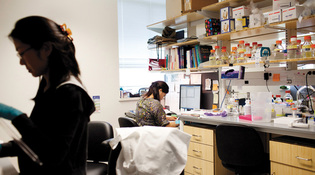 loading
loading
West Campus: The pioneers Christopher CapozzielloIn James Rothman's lab, a research team of biologists, physicists, and engineers capitalizes on advances in engineering to take detailed pictures of cellular components in motion. View full image
Watching the cell at work Vesicles are tiny sacs inside animal and plant cells that transport important proteins. Like self-enclosed spacecraft, they move about the cell, docking onto their destinations. When that destination is the cell’s outer membrane, for example, they deliver their cargo by fusing their membranes with the cell’s and emptying their contents into the outside world. When it’s time to leave that spot, they pinch away, then move on to their next target. This elegant process is one that James Rothman, chair of cell biology and a 2010 winner of the Kavli Prize, has spent more than 30 years elucidating. Rothman came to Yale from Columbia University in 2008. In the 1990s, he helped discover the general mechanism by which membranes fuse. Now he studies how the process works between neurons, which use vesicles filled with neuro-transmitter to communicate. He has had a variety of co-authors. “What’s remarkable about this work,” he says, “is how its success has required a combination of cell biologists, biochemists, engineers, and physicists.” Rothman’s team studies the behavior of vesicles in isolation from their parent cells, observing them with advanced imaging technologies that allow them to measure the timing and efficiency of the fusion. With associate research scientist Erdem Karatekin, whose background is in chemical engineering and physics, Rothman created a model of nerve transmission in which synthetic vesicles behave in a test tube much as they do in nature—traveling between membranes, fusing, and releasing their contents. Rothman has also returned “with vigor” to the Golgi apparatus, a structure inside the cell that processes and moves vesicles from one place to another. He had stopped investigating the Golgi a decade ago after concluding that the important questions about it couldn’t be studied with existing technologies. But recent advances in microscopy, he says, “allow us, using special tricks, to see fluorescent objects in the cell with much greater precision than was ever possible.” The improvements that make those views possible have come from imaging experts like Karatekin and from other engineers and physicists. Collaborating with non-biologists, then, is fundamental to his work, and Rothman hopes that the West Campus will foster more such interactions. “Certainly there have been many successes of interdisciplinary research at Yale, and I would like to count [mine] among them,” he says. “There is no more important means that we have at our disposal to advance the causes of science and medicine.”
|
|